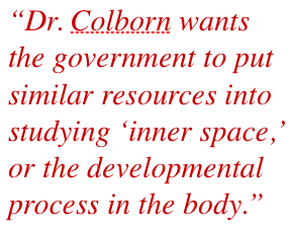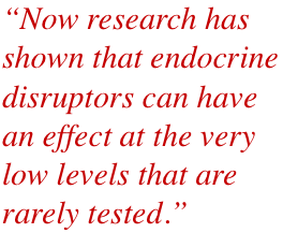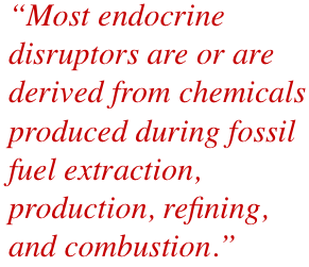The Effects of Endocrine Disrupting Chemicals
"One key characteristic of hormones is that they work at extremely low levels. Very tiny amounts of hormones have effects in the endocrine system. Some hormones work at the level of parts per trillion—this is like one drop of water in 20 Olympic-size swimming pools."

Carol Kwiatkowski, PhD, is the Executive Director of the Endocrine Disruption Exchange, or TEDX—a Colorado-based non-profit founded in 2003 that focuses on health and environmental problems caused by low-dose and ambient exposure to endocrine disruptors. Prior to joining TEDX, Dr. Kwiatkowski completed a PhD in Cognitive Science at The University of Denver and worked as an Assistant Professor at the University of Colorado School of Medicine.
Interviewed by Amy Coombs, April 2014
What is the history of TEDX? What is your mission?
At TEDX, we compile and disseminate scientific evidence on low level exposure to chemicals in the environment that affect our endocrine, or hormone, system. Our work focuses on endocrine disruptors and other chemicals that impact the body at low levels of concentration. Endocrine disruptors affect nearly everything in the body because they disrupt normal hormone function, so there are a lot of problems that fall under this umbrella.
We are also looking at air and water contamination due to fracking, as many of the chemicals used are endocrine disruptors. For example, polycyclic aromatic hydrocarbons are endocrine disruptors, and studies have shown that the children of exposed pregnant women can be impacted.
TEDX was founded by Dr. Theo Colborn, Professor Emeritus at the University of Florida, Gainesville, and formerly senior scientist and director at the Wildlife and Contaminants Program at the World Wildlife Foundation. Frustrated with the lack of regulatory solutions for chemicals, Colborn founded a non-profit that helps bridge science and policy to benefit public health.
Interviewed by Amy Coombs, April 2014
What is the history of TEDX? What is your mission?
At TEDX, we compile and disseminate scientific evidence on low level exposure to chemicals in the environment that affect our endocrine, or hormone, system. Our work focuses on endocrine disruptors and other chemicals that impact the body at low levels of concentration. Endocrine disruptors affect nearly everything in the body because they disrupt normal hormone function, so there are a lot of problems that fall under this umbrella.
We are also looking at air and water contamination due to fracking, as many of the chemicals used are endocrine disruptors. For example, polycyclic aromatic hydrocarbons are endocrine disruptors, and studies have shown that the children of exposed pregnant women can be impacted.
TEDX was founded by Dr. Theo Colborn, Professor Emeritus at the University of Florida, Gainesville, and formerly senior scientist and director at the Wildlife and Contaminants Program at the World Wildlife Foundation. Frustrated with the lack of regulatory solutions for chemicals, Colborn founded a non-profit that helps bridge science and policy to benefit public health.

How did you come to study fracking?
Dr. Colborn was contacted nearly a decade ago by someone who had a rare adrenal tumor. The woman was living by a natural gas (fracking) operation in Colorado. At the time no one knew we were at the beginning of a huge fracking boom, and the public wasn’t as aware that the natural gas industry used so many chemicals. We started collecting MSDS sheets on the chemicals being used and we did a literature review to learn more about the health effects. We identified over 600 chemicals, many of which are air pollutants and endocrine disruptors. We then conducted an air sampling study and published a list of the chemicals we detected.
Dr. Colborn emphasizes the importance of exploring “inner space” instead of “outer space.” Could you explain?
The United States has spent a lot of money on space exploration. We launched a huge space initiative and a lot of funding still goes towards this. Dr. Colborn wants to see the same concerted effort and funding dedicated to development in the womb. She wants the government to put similar resources into studying “inner space,” or the developmental process in the body.
Could you explain the key developmental role for hormone molecules and how endocrine disruption works?
Hormones are the signaling molecules for the body, and they orchestrate everything from growth, development, metabolism and reproduction. They have been linked to intelligence and behavior. This is all mediated through cell receptors that receive hormone signals. These receptors are located all over the body – you have receptors in the nucleus of the cell, and they are in the cell membranes in your tissues and glands. Hormone receptors are even in body fat. This is how your body functions.
One key characteristic of hormones is that they work at extremely low levels. Very tiny amounts of hormones have effects in the endocrine system. Some hormones work at the level of parts per trillion—this is like one drop of water in 20 Olympic-size swimming pools. So when you have environmental chemicals that function like hormones, you can have negative health impacts at very low levels. You only need a small amount to have a big effect.
Endocrine disruptors can bind to receptors like a lock and key. Receptors are designed to receive certain hormones, and the chemicals that mimic hormones also fit into the keyhole. Chemicals can mimic your natural hormones or they can block receptors. Sometimes chemicals can act like a natural hormone to strengthen a weak estrogenic signal. There are also endocrine disruptors that interfere with this process.
Dr. Colborn was contacted nearly a decade ago by someone who had a rare adrenal tumor. The woman was living by a natural gas (fracking) operation in Colorado. At the time no one knew we were at the beginning of a huge fracking boom, and the public wasn’t as aware that the natural gas industry used so many chemicals. We started collecting MSDS sheets on the chemicals being used and we did a literature review to learn more about the health effects. We identified over 600 chemicals, many of which are air pollutants and endocrine disruptors. We then conducted an air sampling study and published a list of the chemicals we detected.
Dr. Colborn emphasizes the importance of exploring “inner space” instead of “outer space.” Could you explain?
The United States has spent a lot of money on space exploration. We launched a huge space initiative and a lot of funding still goes towards this. Dr. Colborn wants to see the same concerted effort and funding dedicated to development in the womb. She wants the government to put similar resources into studying “inner space,” or the developmental process in the body.
Could you explain the key developmental role for hormone molecules and how endocrine disruption works?
Hormones are the signaling molecules for the body, and they orchestrate everything from growth, development, metabolism and reproduction. They have been linked to intelligence and behavior. This is all mediated through cell receptors that receive hormone signals. These receptors are located all over the body – you have receptors in the nucleus of the cell, and they are in the cell membranes in your tissues and glands. Hormone receptors are even in body fat. This is how your body functions.
One key characteristic of hormones is that they work at extremely low levels. Very tiny amounts of hormones have effects in the endocrine system. Some hormones work at the level of parts per trillion—this is like one drop of water in 20 Olympic-size swimming pools. So when you have environmental chemicals that function like hormones, you can have negative health impacts at very low levels. You only need a small amount to have a big effect.
Endocrine disruptors can bind to receptors like a lock and key. Receptors are designed to receive certain hormones, and the chemicals that mimic hormones also fit into the keyhole. Chemicals can mimic your natural hormones or they can block receptors. Sometimes chemicals can act like a natural hormone to strengthen a weak estrogenic signal. There are also endocrine disruptors that interfere with this process.

How do scientists study endocrine disruptors?
Endocrinologists have understood that hormones work at low doses for a long time. But historically people who study environmental chemicals are typically trained as toxicologists rather than as endocrinologists. Toxicologists usually test the impacts of chemicals by giving an organism like an animal a high dose of a chemical. They then test lower doses until they no longer get an effect. This dose is divided by ten or 100 to give a “safe level” or “no effect level.” However these “safe levels” are very rarely tested directly, and the concentrations that fall below the “no effect levels” are also not tested. The lowest doses are assumed to be safe, but now research has shown that endocrine disruptors can have an effect at the very low levels that are rarely tested.
There can also be effects a the low and high levels, but not in the middle range. This is called a non-monotonic dose response curve, and it complicates the process of determining safe levels and testing chemicals for safety.
TEDX examines environmental chemicals, but why not pharmaceutical drugs, many of which are powerful endocrine disruptors?
I have a lot of respect for people who study pharmaceuticals, but we don’t have the staff or funding to look at this area ourselves. There are so many new drugs coming out each day. It is definitely an area that needs more research – a lot of drugs are hormone-based.
We didn’t make a conscious choice to look at environmental chemicals at the exclusion of pharmaceuticals—it just evolved this way. But environmental chemicals are a unique class when it comes to exposure. People often don’t know how or when they are exposed to the chemicals we study. When you take a drug, you may not know it’s an endocrine disruptor, but the decision to take the medication is conscious. It is then incumbent upon the person prescribing the drug to know and explain the risks and side effects.
Could you explain the multigenerational effects of endocrine disruptors?
When a pregnant mom is exposed, it’s like three generations are being exposed at the same time. Not only is the mother exposed, but so is her developing fetus and the germ cell developing inside the fetus—this is the third generation. This is called multigenerational exposure, and they are all direct exposures. If the great-grandchild (F3) generation is also effected even without being directly exposed, there is a transgenerational effect. This can be a sign that an epigenetic effect or genetic mutation was caused by environmental exposure and passed on to the next generation.
There is evidence that endocrine disorders can have multigenerational and transgenerational effects. Unfortunately there are very few chemicals that have been tested to the F3 generation. It’s hard to study these effects because exposure occurs long before birth. You don’t know what your grandmother was doing when your mother was in her womb. Even exposure to DDT or pharmaceuticals are difficult to link directly to effects in later generations. Another problem is that effects don’t show up until later in a person’s life, and patients can be exposed to many things in between.
Endocrinologists have understood that hormones work at low doses for a long time. But historically people who study environmental chemicals are typically trained as toxicologists rather than as endocrinologists. Toxicologists usually test the impacts of chemicals by giving an organism like an animal a high dose of a chemical. They then test lower doses until they no longer get an effect. This dose is divided by ten or 100 to give a “safe level” or “no effect level.” However these “safe levels” are very rarely tested directly, and the concentrations that fall below the “no effect levels” are also not tested. The lowest doses are assumed to be safe, but now research has shown that endocrine disruptors can have an effect at the very low levels that are rarely tested.
There can also be effects a the low and high levels, but not in the middle range. This is called a non-monotonic dose response curve, and it complicates the process of determining safe levels and testing chemicals for safety.
TEDX examines environmental chemicals, but why not pharmaceutical drugs, many of which are powerful endocrine disruptors?
I have a lot of respect for people who study pharmaceuticals, but we don’t have the staff or funding to look at this area ourselves. There are so many new drugs coming out each day. It is definitely an area that needs more research – a lot of drugs are hormone-based.
We didn’t make a conscious choice to look at environmental chemicals at the exclusion of pharmaceuticals—it just evolved this way. But environmental chemicals are a unique class when it comes to exposure. People often don’t know how or when they are exposed to the chemicals we study. When you take a drug, you may not know it’s an endocrine disruptor, but the decision to take the medication is conscious. It is then incumbent upon the person prescribing the drug to know and explain the risks and side effects.
Could you explain the multigenerational effects of endocrine disruptors?
When a pregnant mom is exposed, it’s like three generations are being exposed at the same time. Not only is the mother exposed, but so is her developing fetus and the germ cell developing inside the fetus—this is the third generation. This is called multigenerational exposure, and they are all direct exposures. If the great-grandchild (F3) generation is also effected even without being directly exposed, there is a transgenerational effect. This can be a sign that an epigenetic effect or genetic mutation was caused by environmental exposure and passed on to the next generation.
There is evidence that endocrine disorders can have multigenerational and transgenerational effects. Unfortunately there are very few chemicals that have been tested to the F3 generation. It’s hard to study these effects because exposure occurs long before birth. You don’t know what your grandmother was doing when your mother was in her womb. Even exposure to DDT or pharmaceuticals are difficult to link directly to effects in later generations. Another problem is that effects don’t show up until later in a person’s life, and patients can be exposed to many things in between.

On a practical level, what can people do to minimize exposure to EDCs?
There are a lot of things you can do. Use glass storage containers instead of plastic. Drink out of glass or stainless steel cups and water bottles. Don’t microwave plastic. This is all good advice for avoiding the bisphenol A that leaches out of plastic. Avoid canned foods, which are lined with bisphenol A. Definitely don’t take thermal receipts unless you need them; these are the kind of receipts you can write on with your fingernails, and they are coated in bisphenol A. The chemicals aren’t bound to the paper, so the bisphenol A can migrate to your pocket or hand. Some products are now made with bisphenol S, which may not be any better.
Of course bisphenol A isn’t the only chemical to avoid. Don’t use non-stick pans because there are perfluorinated compounds in the coatings. Buy organic if you can to avoid exposure to pesticides and the inerts in pesticide products. Avoid fragrances, which often contain phthalates to carry the fragrance into the body, and they help the fragrance last longer. Think about things like bath toys, which are often made with phthalates. My kids survived just fine without bath toys. My over-arching message is “learn more and use less”—don’t buy things you don’t really need. Remember the old ‘reduce, reuse, recycle’ – reduce is the first step. You can look for products that are bisphenol A and phthalate free, but sometimes the substitutions are chemicals we know less about—they aren’t necessarily better. So try to buy less plastic and fewer synthetics.
I tell people to go at their own pace. People get paralyzed sometimes because there is so much information. The headlines scream about all the diseases and disorders related to chemicals. Sometimes it seems like we can’t do anything without being exposed. Keep in mind that little changes matter. You don’t have to do a total over-haul of your life if you aren’t ready. Most people have something in their lives that tickles in the back of their mind – maybe your non-stick pan is all scratched up. Go ahead and get rid of it because it’s bothering you. Replace it with a stainless steel or cast iron pan. Maybe you have been worried about the plastic cooking dishes going in the microwave. Stop doing that. If you make one little change, something else will bubble up, and this can become the next thing you address. If you make changes this way, it feels good because you are letting go of things that are bothering you. If you are constantly learning a little more and paring back, you will find that over-time you make a lot of painless changes. You need to make changes that reinforce good feelings rather than make sacrifices.
What are the three most important things regulators should do to protect people from EDCs?
There are several bills on the table to over-haul the 1976 Toxic Substances Control Act. Unfortunately some have been written by industry, and none of the proposals address endocrine disruption. Endocrinology should be the backbone of regulations—it’s not just about big chemical spills or occupational exposure. Of course, those things are important, but we also need to address the biggest threats that the general public faces on a daily basis . Finally, we need to get off fossil fuels and fund green chemistry. Most endocrine disruptors are or are derived from chemicals produced during fossil fuel extraction, production, refining, and combustion. When they drill for natural gas, coal, or oil, the chemicals that come up with the fossil fuels become feed stocks for the EDC’s used to create resins, plastics, paints, and flame retardants. We need to find a way to make things that don’t harm our health.
There are a lot of things you can do. Use glass storage containers instead of plastic. Drink out of glass or stainless steel cups and water bottles. Don’t microwave plastic. This is all good advice for avoiding the bisphenol A that leaches out of plastic. Avoid canned foods, which are lined with bisphenol A. Definitely don’t take thermal receipts unless you need them; these are the kind of receipts you can write on with your fingernails, and they are coated in bisphenol A. The chemicals aren’t bound to the paper, so the bisphenol A can migrate to your pocket or hand. Some products are now made with bisphenol S, which may not be any better.
Of course bisphenol A isn’t the only chemical to avoid. Don’t use non-stick pans because there are perfluorinated compounds in the coatings. Buy organic if you can to avoid exposure to pesticides and the inerts in pesticide products. Avoid fragrances, which often contain phthalates to carry the fragrance into the body, and they help the fragrance last longer. Think about things like bath toys, which are often made with phthalates. My kids survived just fine without bath toys. My over-arching message is “learn more and use less”—don’t buy things you don’t really need. Remember the old ‘reduce, reuse, recycle’ – reduce is the first step. You can look for products that are bisphenol A and phthalate free, but sometimes the substitutions are chemicals we know less about—they aren’t necessarily better. So try to buy less plastic and fewer synthetics.
I tell people to go at their own pace. People get paralyzed sometimes because there is so much information. The headlines scream about all the diseases and disorders related to chemicals. Sometimes it seems like we can’t do anything without being exposed. Keep in mind that little changes matter. You don’t have to do a total over-haul of your life if you aren’t ready. Most people have something in their lives that tickles in the back of their mind – maybe your non-stick pan is all scratched up. Go ahead and get rid of it because it’s bothering you. Replace it with a stainless steel or cast iron pan. Maybe you have been worried about the plastic cooking dishes going in the microwave. Stop doing that. If you make one little change, something else will bubble up, and this can become the next thing you address. If you make changes this way, it feels good because you are letting go of things that are bothering you. If you are constantly learning a little more and paring back, you will find that over-time you make a lot of painless changes. You need to make changes that reinforce good feelings rather than make sacrifices.
What are the three most important things regulators should do to protect people from EDCs?
There are several bills on the table to over-haul the 1976 Toxic Substances Control Act. Unfortunately some have been written by industry, and none of the proposals address endocrine disruption. Endocrinology should be the backbone of regulations—it’s not just about big chemical spills or occupational exposure. Of course, those things are important, but we also need to address the biggest threats that the general public faces on a daily basis . Finally, we need to get off fossil fuels and fund green chemistry. Most endocrine disruptors are or are derived from chemicals produced during fossil fuel extraction, production, refining, and combustion. When they drill for natural gas, coal, or oil, the chemicals that come up with the fossil fuels become feed stocks for the EDC’s used to create resins, plastics, paints, and flame retardants. We need to find a way to make things that don’t harm our health.
